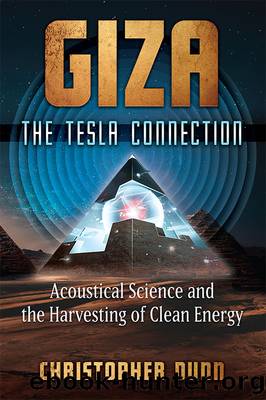Giza by Christopher Dunn

Author:Christopher Dunn
Language: eng
Format: epub
Publisher: Inner Traditions/Bear & Company
Figure 6.7. Construction and successful test of Gantenbrinkâs door model.
When everything was assembled, the ancient Egyptiansâ level of design sophistication immediately became apparent. Once the pins on the shaft side were bent by 90 degrees with the looped end inserted into the hole, the pins were locked in position and could not rotate.
The most important discovery is the design of the two pins. Judging by their relationship to the size of the space, the pins are approximately 5/16 inch (.8 cm) in diameter. Figure 6.4 shows the metal looping around, with an apparent gap where the loop on the right pin seemingly disappears into the limestone block. The left pin shows signs of corrosion, similar to those in the main shaft, though not as severe. There also seems to be a white deposit around the left pin and its hole, while the right pin has what appears to be a black ring encircling the hole that penetrates through to the main shaft.
What was revealed by the Djedi robot describes an electrical device that was accessible to workers for maintenance. Considering the erosion on the pins in the main shaft (the negative electrode having broken off in antiquity) and considering the extreme tapering that was more than likely caused by the rise and fall of a corrosive liquid, another significant conclusion is that these electrodes must have been replaced periodically. At the same time, the electrical cables were probably replaced, and some of the shielding was left in the space. The pins were made so that they could be removed easily and others put in their place. However, a more efficient method would be to have a replacement block with new electrodes already fitted to drop into place after removing the existing one.
I should note here that, as with the entry location of the chemical supply shafts, my design for the wiring of the Gantenbrinkâs door electrodes is speculative, and, similar to the location discovered in the Queenâs Chamber North Shaft, when future expeditions are able to access and physically examine the area around the electrodes, they may find a completely different design. Whatever that design turns out to be, I have no doubt that it will make sense.
From the buildup of salt on the walls of the Queenâs Chamberâup to one inch (2.54 cm) thickâto the design characteristics and other evidence discovered in the shafts, to the ânoisome odorâ assailing early visitors, everything about this chamber speaks of chemistry. Whether the chemistry is that of Drejewski, Cohen, or another preferred formula, there is no denying that only when analyzed through the prism of chemistry do we start to reveal answers to a millennia-old mystery.
Download
This site does not store any files on its server. We only index and link to content provided by other sites. Please contact the content providers to delete copyright contents if any and email us, we'll remove relevant links or contents immediately.
The Complete Stick Figure Physics Tutorials by Allen Sarah(7307)
Secrets of Antigravity Propulsion: Tesla, UFOs, and Classified Aerospace Technology by Ph.D. Paul A. Laviolette(5309)
Thing Explainer by Randall Munroe(3877)
The River of Consciousness by Oliver Sacks(3540)
The Order of Time by Carlo Rovelli(3145)
How To by Randall Munroe(3035)
A Brief History of Time by Stephen Hawking(2962)
I Live in the Future & Here's How It Works by Nick Bilton(2935)
The Great Unknown by Marcus du Sautoy(2648)
What If?: Serious Scientific Answers to Absurd Hypothetical Questions by Randall Munroe(2637)
Midnight in Chernobyl by Adam Higginbotham(2483)
Blockchain: Ultimate Step By Step Guide To Understanding Blockchain Technology, Bitcoin Creation, and the future of Money (Novice to Expert) by Keizer Söze(2449)
Networks: An Introduction by Newman Mark(2360)
The Meaning of it All by Richard Feynman(2300)
Easy Electronics by Charles Platt(2282)
The Tao of Physics by Fritjof Capra(2231)
Midnight in Chernobyl: The Untold Story of the World's Greatest Nuclear Disaster by Adam Higginbotham(2177)
When by Daniel H Pink(2083)
Introducing Relativity by Bruce Bassett(2080)
